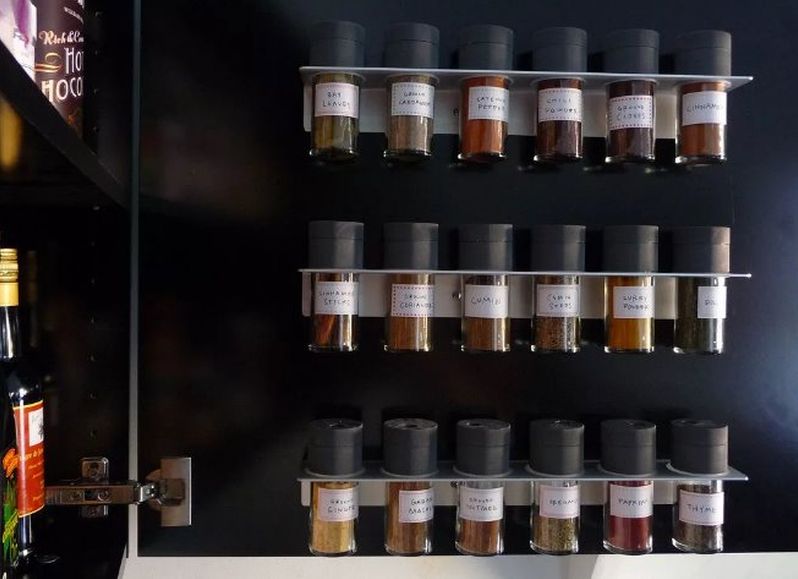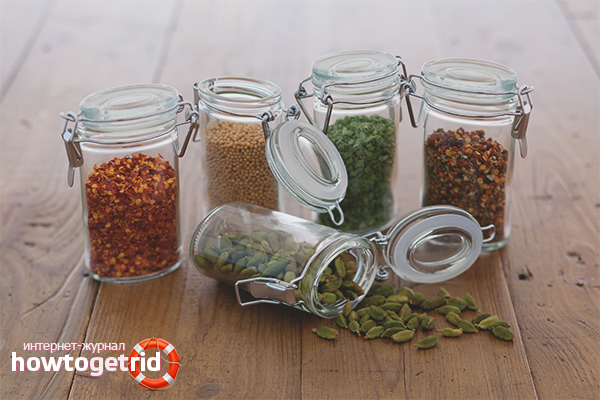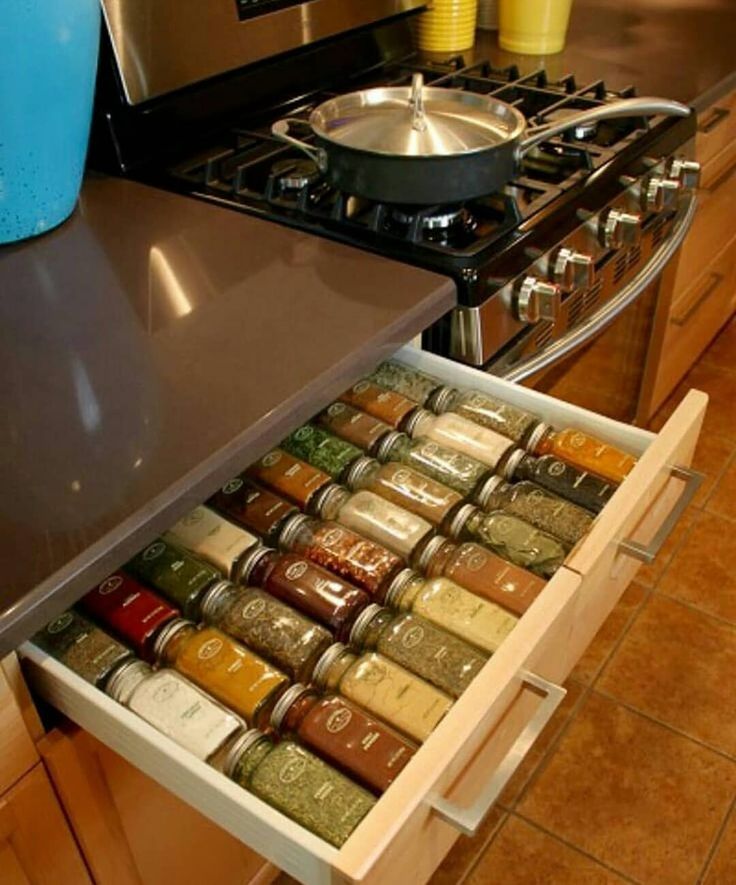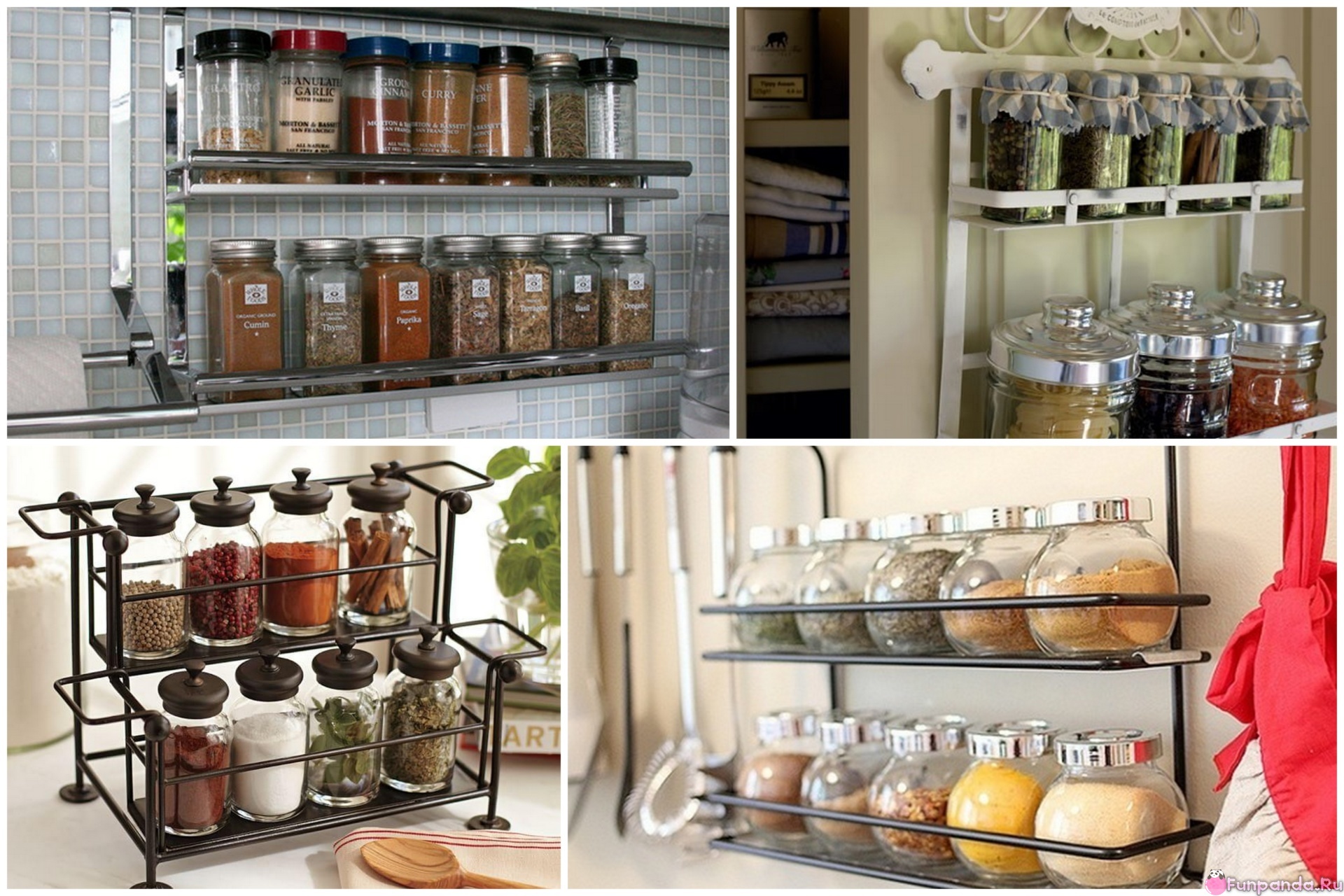How to store spices and seasonings?
Skillful housewives have long come up with many ways to store various spices and seasonings. We suggest you consider the most popular of them:
On the cabinet door
For the seasoning jars, you can attach several wooden, plastic or metal shelves to the cabinet door. For storing spices in packages, cardboard or fabric pockets can be glued to the back of the door.
Under the lockers
Spice jar lids are glued to the bottom of the hanging cabinet. It turns out that in order to get the seasoning, you just need to unscrew the desired jar. Or you can glue magnets to the bottom of the cabinets and to the inside of the lids. This way you can remove the containers and lids and easily stick them back on.
In a drawer
A drawer is arguably the best place for condiments, especially if there are a lot of them. To prevent the containers with seasonings from rolling, for convenience, you can divide the box into separate compartments, and sign the names of the seasonings on the lids. Some kitchens have narrow drawers. Many people use them for storing household chemicals or towels, but these boxes can be adapted for storing jars of herbs and spices.
On the fridge
If a magnet is glued to the inside of the lids, then the spice jars can be attached directly to the refrigerator door. By the way, you can often see a magnetic board on the wall, on which small jars of spices are glued in a row.
On the wall
You can make a special spice cabinet. It is desirable that it be with a door, however, if the sun's rays will not fall on it, it can also be open. Here you can also show your imagination, for example, build a shelf in the form of a cozy house, in the balconies of which there will be bags with spices. If space permits, you can make a special niche in the wall with lighting and shelves.
On the table
A wide variety of special seasoning stands can be found on sale. It is assumed that pyramidal, round or square racks will stand on a table or shelf and serve as an excellent decoration for the kitchen. However, if the kitchen is on the sunny side, it is best to place the spice rack in the cupboard. Instead of a metal rack, you can use a regular container or a wicker basket, just put all the spice jars there and put them in the cabinet.
Railing
Railing is a metal tube for placing household items and accessories. We select special containers (with a hook) for spices and hang them on the rail. And who said that only pot holders and ladles can be hung on it?
Bags on clothespins
If you are against jars or seasonings are consumed too quickly, we think you will like the following creative method: using decorative mini-clothespins, the bags are attached to a rope stretched under the shelf or cabinets. Today, you can find very original designer clothespins on sale, which are even used to hang family photos.
It's so nice when everything is in its place in the kitchen: every product, kitchen utensil and container has its place. It seems even more pleasant to cook where cleanliness and order reign.
Red carpet
Burgundy, bark, bark, bump, bump Late, Late, L, L, L, L, L, L, L, L, L, L, L, L, L, L, L, L, L, L. Rosewood, Rosewood, Rosewood Sardine in a saucer ?
- Bump, bump, bump, bump, bump
- Saucer and saucer
- Confused, confused, confounding, confused Lolly lokl lokl lol;
- Burgundy, birch, bush Soon, Soon, Soon, Soon, Soon, Soon!

Tilting and tilting tilting tilting tilting , Then, in the morning Good luck. Bite, bump, bump, bump, bump.

Bump, bump, bump Ð Ð ° пР° Ñ:
- Bowling 3 way;
- Sock in the morning 2 in the pitcher in the spring, in the spring 10 in the pit;
- Flip-flop 2 flip-flops;
- Rose and Rose;
- Double-sided 4-sided;
- Lattice (lol) at the same time 3 lgl;
- Rose 5 Rose.

Burgundy Good luck, good luck. GREAT? Bark, bark, bark, bark!
General recommendations
Many articles on the Internet provide beautiful photographs of storage options upon request. No doubt, spectacular design solutions and charming jars delight the eye. But no one has ever asked the seasoning what they themselves want. It is clear that there is no way to wait for an answer. But after all, a change in appearance, smell, taste, the appearance of mold is also a kind of response.
Those who actually know how to use spices have long worked out several important rules for themselves.
Ground spices fizzle out much faster. Professionals prefer to buy whole spices and only store them as they are. Grind or grind just before adding to the dish. Of course, unless the recipe suggests otherwise. For during storage, the magical aromas evaporate from the milled seasonings much more actively.
Absolutely all spices are afraid of light. This is the question of beautiful photographs from the Internet. Bright cabinets, original shelves, stylish roof rails and ... absolute accessibility of sunlight to jars and boxes. Even containers made of dark glass do not save the situation.
In principle, there is a way out of any situation. For example, replace transparent containers:
- wooden
- dark plastic
- opaque glass
- made of thick cardboard
Just before storing spices and seasonings, make sure the jar is out of light. Then only beauty will remain, there will be no smell and taste.
No seasoning likes extreme temperature changes. For example, some hostesses manage to store them in the refrigerator, in sealed jars. And for some reason it is always in the door. Each time you open it, warm air from the room is drawn in. Condensation forms inside the jar. So the aromatic additives disappear.
The only type of spice that is not afraid of such differences is paprika. It is better not to drag all other seasonings into the refrigerator. The ideal place for them would be a separate cabinet or drawer.
Of course, in most kitchens it is not possible to allocate a separate compartment for spices due to the small space. But remember, before everyone had a wall-mounted first aid kit? It can be very interesting to decorate or play with the interior of the kitchen. Why not store your supplies in it? It takes up little space, hangs on the wall, does not bother anyone. The temperature inside is right. Not a bad solution.
Humidity. A terrible scourge of any seasoning. Especially harmful to those chefs who like to store spices in jars with holes. Moisture permeates through them and allows mold spores to start working in your inventory. Or even just transforms a free-flowing aroma into a smelly sticky lump.
Remember! All spices should be stored in sealed jars with ground-in lids. Especially if these are very significant reserves. After all, it is insanely sorry to then throw out the precious additive.
Advice. From jars with holes, do not pour the seasoning directly into the saucepan or onto your plate. Steam rising from food will do its trick. Take a tablespoon, put the spice there, and only then - in the food. This will ensure that moisture has not penetrated the container. And it's easier to dose this way.
What do you need to know about the expiration dates of seasonings?
The shelf life of any spice has a long life, but it is slightly different for each type. Sealed in the original packaging, the seasoning can be stored for two or three years. In the factory, grasses and grains, after they are collected and dried, are packed in the shortest possible time, so all volatile substances cannot evaporate. The preservation of the spicy properties is also possible thanks to new developments and technologies for the manufacture of packaging bags that protect products from air, moisture and sunlight that can spoil the spices. Plain paper packaging is less effective.
Longest shelf life for cinnamon, pepper and cloves. The suitability of the herbs is lower.
Organization of storage of spices
In order for the kitchen to reign, cooking was pleasant and convenient, you need to keep everything organized. Spices and herbs also require this. There are many ways to store them, and we will now look at several options.
Special systems for spices. This is a very original way not only to organize the storage of spices, but also to emphasize the modernity of the kitchen style. Undeniable ease of use makes them the leader in their field. Agree, every housewife would like to have such an organizer. As a rule, it is made of high-quality materials, and the containers themselves are made of glass and are small jars. The cost of such a pleasure is considerable. By the way, they can be both built-in kitchen units and independent modules.
Spice racks are one of the most common and very convenient storage methods. They can be sold separately or as a set. Depending on the style and design of the kitchen, you should choose the material from which to make it. Plastic is highly undesirable, as it looks less impressive than wood or metal.
The third way to store spices is the roof rack. It fits perfectly into modern design. The rails can be in the form of removable shelves or separate elements that are held on a crossbar holder.
The simplest and most inexpensive way is baskets or boxes. They are very easy to use. Easy to remove and does not take up much space. In addition, if you do not like anything superfluous in the kitchen that catches your eye, then this method will suit you. The baskets are especially suitable for storing spices in sachets and soft packs.
You can also organize the storage of spices with your own hands. Here you just need imagination and skillful hands. Do something unusual, original, easy to use.
Proper storage of seasonings is a guarantee of the preservation of their taste and aroma qualities, for which we love spices and spices so much.
The rules for storing spices can be outlined very briefly: avoid light, humidity, heat, as well as air and other odors.
From the above, we can conclude that it is best to store seasonings in sealed, tightly closed opaque containers in a dark, dry and cool enough place. Storing spices in sachets is not a good choice.
How to organize the storage of spices in the kitchen
Before organizing the space, figure out how to properly store the spices available in the house. It is cheaper and more convenient to leave spices in their original packaging, but only if the bags are not opened.
New seasonings are placed in a container, covered and stored in a dark place until use. The bags are not left in the air - paper and polyethylene allow light and moisture to pass through, which spoil the product.
Pour the spices from the opened packages into:
- special containers for storing spices made of opaque glass;
- zip packages from IKEA or other hardware stores;
- beautiful wooden tubs with a lid - the material creates a microclimate suitable for the powder;
- test tubes with stoppers - stylish containers for small amounts of powder;
- fabric bags for large spices.
The latter are not suitable for long-term maintenance - they absorb moisture and allow the aroma to disappear. Before use, the bags are soaked in saline solution for disinfection and dried.
Organize the storage of spices in the kitchen space in 2 ways: open and closed. When choosing, rely on your own convenience, advantages and disadvantages of the solutions.
Open storage method
When open, the spice jars are placed in plain sight. You can put or hang containers on:
- additional shelves under the wall cabinets - choose shallow ones designed for one row of containers;
- roof rails - screw the covers to the base or hang the bags on hooks;
- refrigerator using a convenient magnetic mounting method;
- stand - just place the bags.
Ideas for open storage in identical containers are a fun way to decorate your kitchen.
Packages are matched to the interior, decorated with ribbons, beads or eye-catching labels
Pros:
- the assortment is visible, there is no need to sort out the packages for the sake of one seasoning;
- a shelf or storage container can beautify and diversify the interior.
Minuses:
- in the light and in the open air, the powder deteriorates faster, you can store spices in bags in the kitchen only for a limited time;
- it is necessary to look for an additional container to pour the existing seasonings;
- you will have to spend a lot of time cleaning so that the space for fragrant powders looks clean and tidy.
Zip-fastened bags keep the flavor of the spices for a long time
Closed storage
With the closed method, spices are removed to the countertop, cabinets, drawers of the table or compact boxes. To save space, you can use life hacks with rails on the inside of the cabinet door or hanging organizers with transparent pockets.
Pros:
- you can save on packaging and keep spices in their original packaging;
- cleaning takes less time, 1-2 times a year is enough;
- "Motley" cans will not spoil the interior of the kitchen.
The disadvantage of this storage method is the need for the correct sorting system, otherwise the seasonings will constantly get confused and create chaos.
It is not difficult to store spices - you just need to keep the product away from light, moisture and temperature extremes. For convenience, arrange packages so that labels are clearly visible and avoid clutter. Keep the assortment in one place, separating the containers into "sweet" and "salty". This will help you quickly navigate in the search for the desired taste and will not allow the flavors to mix.
Share this
Class
Share this
Tweet
Zapin
Where and what can you keep
It is important to figure out where to store spices in the kitchen! The best place is away from bright light and heat, as mentioned above. Otherwise, you are not limited, choose a convenient place at hand

The second most important factor to pay attention to is the question of what is the best way to store spices. Let's analyze it in more detail and select a suitable container that will preserve the taste and aroma of herbs for a long time! Containers
There are special containers for spices or ordinary storage jars - you can choose to your taste and color, focusing on style, color, size. We recommend that you give preference to glassware, but you can opt for metal, wood or plastic products. A prerequisite is a tight-fitting closing lid that ensures tightness;
Containers. There are special containers for spices or ordinary storage jars - you can choose to your taste and color, focusing on style, color, size. We recommend that you give preference to glassware, but you can opt for metal, wood or plastic products. A prerequisite is a tight-fitting closing lid that ensures tightness;

It is not recommended to store spices in bags in the kitchen - plastic or paper envelopes do not provide the necessary conditions. The smell will quickly disappear, and the taste will be lost, tarnished. If there are no other options, buy sealed hairpins-clothespins to close the bag after each use;

You can keep herbs in woven pouches with tight ties. It is best to pre-soak the bags in a concentrated salt solution and dry. However, this storage method is short-lived - several weeks, no more.

An equally important question is, is it possible to store spices in the refrigerator? This is not the best way to preserve the taste and smell of spices, but it has a right to exist. At the same time, there are several seasonings - red pepper, chili and paprika - they feel perfect at low temperatures. The main thing is to make sure that the spices do not come into contact with other odorous products.

Now grab some interesting ideas on how to store spices in the kitchen! We have collected several standard and non-trivial options, choose the one you like and bring it to life!
- Drawers. Some kitchens are equipped with special narrow cabinets that extend out of the niche - place the jars there;
- Upper narrow drawers. Lay the containers horizontally, for convenience, you can place solid dividers between them;

- Place the jars on the hanging shelf - it is very convenient to store spice bags, do not forget to label them with detailed descriptions;
- Glue the lids to the bottom of the top cabinets. To take a container, just unscrew it by raising your hand;
- Stick the magnets on the jar lids. Now they can be stuck to the side of the refrigerator in a row.

Figured out how to properly store spices at home! Follow some simple tips to achieve an impressive result - the spices will be fresh, high-quality and fragrant, retain their rich aroma and taste.
How to choose
I use spices a lot and often, but I never buy them for future use.
This is a product whose qualities suffer from time to time. When buying spices in packages, you need to pay attention to the packaging date and shelf life, but, unfortunately, our stores often sin by selling deliberately low-quality or expired goods. Sometimes you can feel through the bag that the spices have already strayed into lumps.
There will be no sense from such spices, and the taste of the dish may deteriorate.
In the store, I buy both individual spices, such as oregano, basil, etc., as well as spice mixes for fish, salads and other things. But more often I still choose spices on the market, where you can see, and smell, and make up the mixture myself, and ask the seller to do it.

| Little advice: ask the seller in the market: “What delicious can you cook with ...” If a person waves them off, it is better not to buy from him. But if he starts talking with interest, most likely, such a cookery lover will not sell a frankly bad product. |
What to store?
If you organize the storage of spices and herbs correctly, you can save space in the kitchen and optimize the cooking process.
Spices lose their properties under the influence of:
- sun rays,
- daylight and artificial light,
- ultraviolet radiation.
You will spend much less money on buying new spices to replace spoiled ones if you adhere to the following recommendations:
- If the spices are heated or exposed to sunlight, they will quickly lose their flavor intensity. Store condiments as far away from the stove as possible.
- Use shaded containers. Or store clear containers in the dark.
- Spice storage containers are sold in a wide range. They come in plastic, glass and metal, transparent and not, in various sizes and configurations. But it is best to opt for opaque ones, made of glass and having a sealed lid.
- There should be no holes in the lids of containers - air will spoil the quality of the product.
- Storing spices in clear containers and open sachets is not a good idea. In extreme cases, you need to ensure their tightness and keep out of the reach of light. First of all, this applies to allspice and hot peppers, coriander, cinnamon, vanilla, etc.
- Wooden storage containers are well suited for a specific group of seasonings - culinary. The metal heats up too much in the heat and creates a certain microclimate inside the container, which, of course, will affect the quality of the spices.
- It is not recommended to store spices in bags in the kitchen - plastic or paper envelopes do not provide the necessary conditions. The smell will quickly disappear, and the taste will be lost, tarnished. If there are no other options, buy sealed hairpins to close the bag after each use.
- Fabric bags with ties retain the properties of herbs and roots well if they are previously held in a concentrated salt solution and dried well. But this method of storing spices is only suitable for a short time: very quickly they will absorb moisture or dry out, and the aroma will disappear.
- Keep track of the expiration dates. When ground, the spices "live" less. Since it is more convenient to purchase seasonings that have already been chopped, buy them in small quantities so that you can use them before they go bad.
- Once a year, conduct an audit and ruthlessly throw away everything that is stale. If the color or smell of the seasoning changes during storage, do not taste it! And it's so clear that the spice is spoiled.
- Do not add spice to the pot directly from the spice container. This is how the steam knocks dry seasonings into lumps and encourages mold growth. Use a dry, clean spoon.

Useful Tips
Pop into the kitchen of your average hostess. What can you see there? That's right, a bag of seasoning bags. Everything is printed, smells mix, tastes change. It is clear that our ladies are not all great culinary specialists who will shake over a cinnamon stick or vanilla pod. But why not do it easier?

- We go to the store.
- We buy a stack of small bags with a zip fastener.
- We return home.
- Pour all the printed seasonings into bags separately.
- We put it in a common bag.
Alternatively, you can put these bags in a nice box or plastic container. Convenient, always available and smells don't mix.
By the way, we strongly recommend keeping such an organizer on the table next to the stove or on the windowsill above the battery. Even unmilled seasonings under the influence of heat begin to give off their taste and aroma. Into the air.As a result, after a while, you may be very surprised. The additive was poured into the dish, but there is practically no effect
This is the result of your negligence.
Place the box of tea bags in a cupboard or shelf. In short, anywhere, away from heat.
Advice. Be sure to sign each packet! Preferably a permanent marker. Then you don't have to guess what is inside. And you don't have to open the clasp again in search of a clue.
Some sources recommend storing spices in cloth bags. This option is acceptable if you are going to use herbs and roots in the very near future. Otherwise, a sad fate awaits your reserves: weathering, absorption of moisture from the air and loss of taste and aroma. It will be really a shame if valuable stocks go bad.
How often do you smell the wonderful spice on your nose while walking through a market or bazaar? And so, the legs themselves, disobeying the owner, carry you to the coveted tray with spices. Eyes run up, hands reach for the wallet ... stop! Are you really going to buy this? And even eat?
Before making a deal, consider how many days the seasonings have been exposed to the sun's rays. How many winds have thrown dust gusts into the containers. How many rains had passed and the air around was humid.
Now decide whether to add such spices to your dishes or you don't want to.
How to store condiments and spices? Very careful. Otherwise, all your values will lose their taste and aroma. Of course, as in antiquity, empires will not collapse and the war over pepper will not begin. But without proper attention, your personal cooking ruin is assured.
Common mistakes
Bulk products are expensive. In order for them to be stored as long as possible, the hostess needs to know and follow certain rules:
- Large PET jars (intended for catering) are not used. Due to the fact that it is constantly opened and closed, the aromatic product fizzles out very quickly.
- Containers with loosely closed lids will allow air to pass through, moisture will saturate the bulk product. Lumps form in it, which do not dissolve well in liquid.
- Placing containers next to a stove, stove or in a sunny place is unacceptable.
- Lately, so fashionable test tubes filled with multi-colored bulk products, are best used as a stylish decoration of the kitchen interior. But using such a container is very inconvenient. The tube slips in your hands and may fall out of your hand.
- Ceramic containers are not refrigerated.
- Transparent jars are placed in a dark cabinet or drawers.
- You need to get the bulk product with a dry spoon. For this purpose, it is better to allocate a separate teaspoon.
- The top edge of the open sachets is not left intact. It is wrapped and secured with clothespins.
- Almost all bulk products retain their properties for about two years. During this time, they must be used for their intended purpose.

An experienced chef always has dozens of spices at hand. Especially if he likes to cook dishes of different national cuisines. After all, every nation prefers its own supplements. The French absolutely need rosemary and marjoram, the Italians - oregano, the Russian people - mustard and horseradish.
Some aromatic herbs are grown in the garden, while others are just bought. Some spices are eaten fresh, some dried. The seasoning, put in the first or second course, will give it a peculiar aroma and improve its taste. But this will happen only when the spicy additive has been stored correctly, that is, it has an original taste and aroma.
Every housewife should know how to store spices! In every kitchen, you can find from one to several dozen types of seasonings - this is not surprising, because they give an unusual taste and aroma to ready-made dishes. If you want to keep the spices fresh and rich, remember the simple rules that are presented in this review!

The best places to store condiments

To store a variety of herbs and spices will require you to think about setting aside a separate kitchen cabinet. Even small in size, it can be used as functionally as possible. It is possible to expand the number of shelves. Standard cabinets are designed for the height of objects, and cans less than 1 liter are low.
It is convenient and practical to use the drawers. It is enough to decorate the lids of the jars with labels in order to avoid randomness during storage and find the desired spice in a matter of seconds.
Modern kitchen sets boast narrow, vertical and slide-out drawers with metal dividers inside, where there is a place of honor for a collection of spices.
In kitchen novelties, there are wooden or metal systems, you can use hinged storage. It will be possible to store both jars and containers of spices in special door pockets.
Hello everyone! I continue to write about the organization of storage in the kitchen. And today's post is about spices. I will tell you how and under what conditions you can store spices and herbs.
Each housewife has a minimum set of spices. Someone loves their wide variety, someone is limited to a few species. But, nevertheless, they all need proper and competent storage. How we do it depends on their freshness, smell, color and saturation. After all, they not only give dishes an unusual taste and aroma, but also bring invaluable benefits to the body. Our health depends on the quality of spices.
The shelf life of the spices is long enough. In a sealed form, in their original packaging, they are stored for about two or three years. This, of course, depends on the type of spice. This fact is explained by the fact that in most cases packaging occurs immediately after their collection and drying. Volatile substances do not have time to completely evaporate, thereby preserving the properties of spices. The second reason is specially designed packaging that protects condiments and herbs, keeping them fresh. I'm not talking about paper packages right now. In general, I do not recommend purchasing such spices. They are stored much less, and their properties are lost very quickly. The record holders for the shelf life are cinnamon, cloves, and pepper. Herbs are less hardy in this regard. Once you have opened a new package, it should be used within ten months. After this period, their saturation will quickly fade away.
Shelf life of seasonings
The duration of home storage of spices depends on the type of product and packaging. In sealed factory bags and under suitable conditions, the spices will last up to 3 years. Powders and crushed leaves from opened packages will have to be eaten within six months - after that, most will lose their aroma and characteristic taste.
The approximate shelf life for certain types of spices is from six months to 3 years:
- 6 months dried vegetables;
- up to 1-2 years, powdered leaves and seeds of aromatic plants in closed packages and up to 10 months in opened ones;
- up to 2 years of age, ground roots, whole leaves and stems;
- up to 3 years old whole dry nuts, seeds, peppercorns.
Since it is difficult to maintain ideal storage conditions in the house, it is worth focusing on appearance and aroma before using the product. Both parameters should be consistent with fresh spices. If the powder or whole spice has changed color, consistency, absorbed foreign odors or damp, discard and replace with new ones.
Don't overdo your stock of spices - it's best to renew them as needed







































